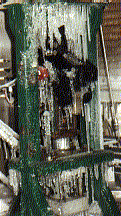| Ice Thickness |
| 6mm -
general conditions, light loading |
| 13mm -
general conditions, medium loading |
| 37mm -
heavy ground loading and marine mast loading |
| 75mm -
extremely heavy ground loading and marine deck loading. |
| Operational
Considerations |
| Some
equipment, covered with ice, may be expected to operate
immediately without undergoing de-icing procedures, other
equipment would not be expected to operate until some
form of de-icing has taken place. Ice removal, if
required, may be performed manually, or automatically by
built-in ice-removal systems or a combination of both. |
| Effects |
 Bonds
moving parts together. Bonds
moving parts together. |
 Added
weight to radar antennas, aerodynamic control surfaces,
helicopter rotors, etc. Added
weight to radar antennas, aerodynamic control surfaces,
helicopter rotors, etc. |
 Increased
footing hazards for personnel. Increased
footing hazards for personnel. |
 Interference
with clearances between moving parts. Interference
with clearances between moving parts. |
 Induced
structural failures. Induced
structural failures. |
 Reduced
airflow efficiency as in cooling systems or filters. Reduced
airflow efficiency as in cooling systems or filters. |
 Impeded
visibility through windshields and optical devices. Impeded
visibility through windshields and optical devices. |
 Degraded
transmission of electromagnetic radiation. Degraded
transmission of electromagnetic radiation. |
 Damage
from mechanical, manual, or chemical ice removal
measures. Damage
from mechanical, manual, or chemical ice removal
measures. |
 Reduced
efficiency of aerodynamic lifting and control surfaces. Reduced
efficiency of aerodynamic lifting and control surfaces. |
 Reduced
(aircraft) stall margins. Reduced
(aircraft) stall margins. |
| Test Variables |
 Accumulated
ice thickness Accumulated
ice thickness |
 Ice removal
method Ice removal
method |
 Test
temperatures and droplet sizes Test
temperatures and droplet sizes |
 Surfaces to
which ice is to be applied Surfaces to
which ice is to be applied |
 Wind
Velocity Wind
Velocity |
 Operability
and pass/fail criteria Operability
and pass/fail criteria |
| Test Apparatus |
 Chamber
with auxiliary instrumentation capable of maintaining and
recording the test conditions. Chamber
with auxiliary instrumentation capable of maintaining and
recording the test conditions. |
 Provisions
to monitor the test specimen temperature. Provisions
to monitor the test specimen temperature. |
 Water spray
delivery and drain system. Water spray
delivery and drain system. |
 Provisions
to measure Ice thickness. Provisions
to measure Ice thickness. |
| Typical Test Procedure |
| 1.
Stabilize the test item temperature at 0° C
(-0/+2°C). |
| 2. Deliver
a uniform, precooled water spray for 1 hour to allow
water penetration into the test item crevices/openings. |
| 3. Adjust
the chamber air temperature to -10°C and maintain the
water spray rate until the required thickness of ice has
accumulated on the required surfaces. |
| 4. Maintain
the chamber air temperature for a minimum of 4 hours to
allow the ice to harden. |
| 5. Examine
for physical damage, safety hazards and attempt to
operate the test item. |
| 6. If there
is a failure or if the specification allows ice removal,
remove the ice. Note the effectiveness of ice removal
techniques used. |
| 7.
Stabilize the test item at standard ambient conditions
and perform a post-test operational check. |
| 8. Examine
for physical damage, safety hazards and attempt to
operate the test item. |
| 9. Document
(with photographs if necessary) the results. |




